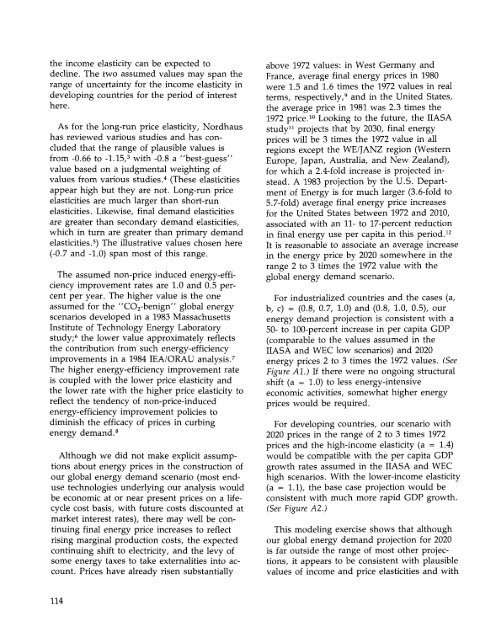ENERGY FOR A SUSTAINABLE WORLD - World Resources Institute
ENERGY FOR A SUSTAINABLE WORLD - World Resources Institute
ENERGY FOR A SUSTAINABLE WORLD - World Resources Institute
You also want an ePaper? Increase the reach of your titles
YUMPU automatically turns print PDFs into web optimized ePapers that Google loves.
the income elasticity can be expected to<br />
decline. The two assumed values may span the<br />
range of uncertainty for the income elasticity in<br />
developing countries for the period of interest<br />
here.<br />
As for the long-run price elasticity, Nordhaus<br />
has reviewed various studies and has concluded<br />
that the range of plausible values is<br />
from -0.66 to -1.15, 3 with -0.8 a "best-guess"<br />
value based on a judgmental weighting of<br />
values from various studies. 4 (These elasticities<br />
appear high but they are not. Long-run price<br />
elasticities are much larger than short-run<br />
elasticities. Likewise, final demand elasticities<br />
are greater than secondary demand elasticities,<br />
which in turn are greater than primary demand<br />
elasticities. 5 ) The illustrative values chosen here<br />
(-0.7 and -1.0) span most of this range.<br />
The assumed non-price induced energy-efficiency<br />
improvement rates are 1.0 and 0.5 percent<br />
per year. The higher value is the one<br />
assumed for the "CO 2 -benign" global energy<br />
scenarios developed in a 1983 Massachusetts<br />
<strong>Institute</strong> of Technology Energy Laboratory<br />
study; 6 the lower value approximately reflects<br />
the contribution from such energy-efficiency<br />
improvements in a 1984 IEA/ORAU analysis. 7<br />
The higher energy-efficiency improvement rate<br />
is coupled with the lower price elasticity and<br />
the lower rate with the higher price elasticity to<br />
reflect the tendency of non-price-induced<br />
energy-efficiency improvement policies to<br />
diminish the efficacy of prices in curbing<br />
energy demand. 8<br />
Although we did not make explicit assumptions<br />
about energy prices in the construction of<br />
our global energy demand scenario (most enduse<br />
technologies underlying our analysis would<br />
be economic at or near present prices on a lifecycle<br />
cost basis, with future costs discounted at<br />
market interest rates), there may well be continuing<br />
final energy price increases to reflect<br />
rising marginal production costs, the expected<br />
continuing shift to electricity, and the levy of<br />
some energy taxes to take externalities into account.<br />
Prices have already risen substantially<br />
above 1972 values: in West Germany and<br />
France, average final energy prices in 1980<br />
were 1.5 and 1.6 times the 1972 values in real<br />
terms, respectively, 9 and in the United States,<br />
the average price in 1981 was 2.3 times the<br />
1972 price. 10 Looking to the future, the IIASA<br />
study 11 projects that by 2030, final energy<br />
prices will be 3 times the 1972 value in all<br />
regions except the WE/JANZ region (Western<br />
Europe, Japan, Australia, and New Zealand),<br />
for which a 2.4-fold increase is projected instead.<br />
A 1983 projection by the U.S. Department<br />
of Energy is for much larger (3.6-fold to<br />
5.7-fold) average final energy price increases<br />
for the United States between 1972 and 2010,<br />
associated with an 11- to 17-percent reduction<br />
in final energy use per capita in this period. 12<br />
It is reasonable to associate an average increase<br />
in the energy price by 2020 somewhere in the<br />
range 2 to 3 times the 1972 value with the<br />
global energy demand scenario.<br />
For industrialized countries and the cases (a,<br />
b, c) = (0.8, 0.7, 1.0) and (0.8, 1.0, 0.5), our<br />
energy demand projection is consistent with a<br />
50- to 100-percent increase in per capita GDP<br />
(comparable to the values assumed in the<br />
IIASA and WEC low scenarios) and 2020<br />
energy prices 2 to 3 times the 1972 values. (See<br />
Figure Al.) If there were no ongoing structural<br />
shift (a = 1.0) to less energy-intensive<br />
economic activities, somewhat higher energy<br />
prices would be required.<br />
For developing countries, our scenario with<br />
2020 prices in the range of 2 to 3 times 1972<br />
prices and the high-income elasticity (a = 1.4)<br />
would be compatible with the per capita GDP<br />
growth rates assumed in the IIASA and WEC<br />
high scenarios. With the lower-income elasticity<br />
(a = 1.1), the base case projection would be<br />
consistent with much more rapid GDP growth.<br />
(See Figure Al.)<br />
This modeling exercise shows that although<br />
our global energy demand projection for 2020<br />
is far outside the range of most other projections,<br />
it appears to be consistent with plausible<br />
values of income and price elasticities and with<br />
114

















